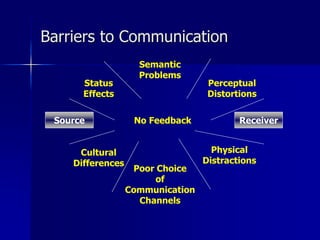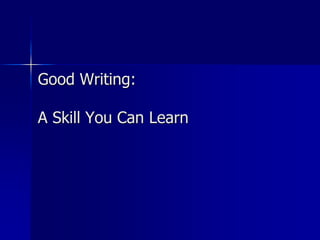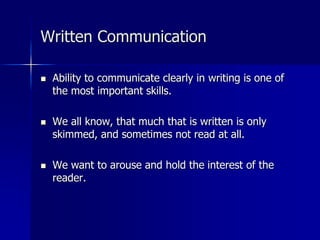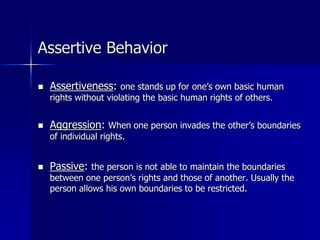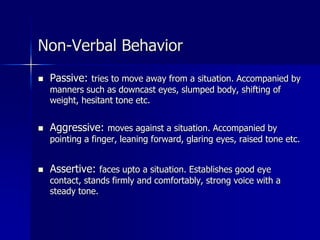Effective Communication.ppt
- 1. Effective Communication – The Growth & Productivity Driver!
- 2. Nothing in life is more important than communicating effectively - Gerald Ford
- 4. Workshop Plan Communication Process Questioning Techniques Listening Skills Written Communication Assertive Behavior
- 5. Is Effective Communication Really Necessary?
- 6. Syndicate Activity Benefits of Communication specific to your role. Process of communication. Barriers to communication. 15 minutes to prepare
- 8. Communication Process Source Encoding Transmission Decoding Receiver Noise Feedback
- 9. Good Communication Seek to clarify your ideas before communicating. Examine true purpose of each communication. Consider total physical and human setting. Be mindful of the tone/volume. Consult with others, where appropriate in planning communication. Make sure that your actions support your communication. Seek not only to be understood, but to understand. Follow up your communication.
- 10. Barriers to Communication Source Receiver No Feedback Semantic Problems Poor Choice of Communication Channels Status Effects Perceptual Distortions Cultural Differences Physical Distractions
- 11. Communication - Cs Completeness: – Message is complete when it contains all the facts that the receiver needs for the action he desired. – Answer all the questions asked. – Check for five Ws - who, why, what, when and where. Conciseness: – Contributes to emphasis. – Eliminate unnecessary words. Clarity: – Choose short, familiar, conversational words. – Include examples, illustrations and other visuals.
- 12. Communication - Cs Courtesy: – Helps to strengthen business friendship. – Be sincere, tactful, thoughtful and appreciative. – Wish or apologize as per the occasion. Correctness: – Use the right level of language (more than proper grammar). – Include only accurate figures, facts and words.
- 13. The Real World Communication...
- 14. Six Messages Involved In Communication What you mean to say What you really say What the other person hears What the other person thinks he heard What the other person says about what you said What you think the other person said about what you said.
- 15. What you mean to say – “The moon puts me in a romantic mood” What you really say – “Isn’t that a brilliant moon?” What the other person hears – “The moon is bright.” What the other person thinks he heard – “Yes.it’s bright enough for a walk.” What the other person says about what you said – “Yes, it’s bright enough for you to read.” What you think the other person said about what you said. – “I don’t feel romantic”.
- 16. Communication Elements Questioning Techniques Listening Written communication Assertive behavior
- 17. Communication Elements Words Body Language Voice/Modulation
- 18. Research shows, communication is… body language 55% words 7% Voice 38%
- 19. Body language is a broad term for several forms of communication using body movements or gestures, instead of, or as a complement to, sounds, verbal language, or other forms of communication. What It Is?
- 20. Body language convey important messages that color, support or contradict the words people use. Messages that are key to a situation – but that participants feel cannot be publicly or verbally acknowledged – are sent through these channels. Importance
- 21. Voluntary body language Involuntary body language Components Of Body Language
- 22. It refers to movement, gestures and poses intentionally made by the person (smiling, hands, imitating actions), and generally making movements with full or partial intention of making them and a realization of what they communicate. Voluntary Body Language
- 23. Facial expressions are often a form of involuntary body language, and a means for one to 'read' the expressions — and so emotions — of another. Involuntary Body Language
- 24. No gesture has a single, unvarying meaning. The meaning depends on cultural norms, personal styles, the physical setting, what has gone before and what both parties anticipate for the future. For example – arms crossed against the chest Living With Ambiguity
- 25. Eye-to-eye contact is one of the most direct and powerful ways in which people communicate nonverbally. Prolonged eye contact is usually taken to be either threatening or, in another context, a sign of romantic interest. Example
- 26. Raising or knitting of the eyebrows Widening of the pupils Flaring or wrinkling of the nose Tightening of the nose Baring or clenching of the teeth Speakers In Body Language
- 27. Reading a facial expression is a complex process because a face often shows a mixture of several feelings at once, matching the mixture of the feelings that the person may be experiencing inside. The Challenge…
- 28. Body Language Clues Open mindedness is shown by: Open hands Unbuttoned coat
- 29. Wariness is shown by: Arms crossed on chest Legs over chair arm while seated Sitting in armless chair reversed Crossing legs Fist-like gestures Pointing index finger Karate chops
- 30. Thinking/analyzing is shown by: Hands to face gestures Head tilted Stroking chin Peering over glasses Taking off glasses - cleaning Glasses earpiece in mouth Pipe smoker gestures Getting up from table - walking Putting hand to bridge of nose BODY LANGUAGE CLUES
- 31. Confidence is shown by: Steepling of hands Hands on back of head- authority position Back stiffened Hands in coat pockets, with thumb outside Hands in lapels of coat BODY LANGUAGE CLUES
- 32. Territorial dominance is shown by: Feet on desk Feet on chair Leaning against or touching object Placing object in a desired space Hands behind head- leaning back BODY LANGUAGE CLUES
- 33. Nervousness shown by: Clearing of throat Whew sound Whistling Cigarette smoking Picking/pinching flesh
- 34. Nervousness shown by: Hands covering mouth while speaking No looking at the other person Tugging at trousers or skirt while seated Jingling money in pockets Tugging at ear Perspiration or ringing of hands Fidgeting in chair BODY LANGUAGE CLUES
- 35. Expectancy shown by: Rubbing palms Jingling money Crossed fingers BODY LANGUAGE CLUES
- 36. Suspicion shown by: Not looking at you Arms crossed Moving away from you Silhouette body towards you Side ways glance
- 37. Suspicion shown by: Touch/ rub nose Rubbing eyes Buttoning coat Drawing away BODY LANGUAGE CLUES
- 38. Alertness/ attention shown by: Hands on hips Hands on mid thigh when seated Sitting on edge of chair Arms spread, gripping edge of table/ desk Moving closer Open hands Hand to face gestures Unbuttoning coat Tilted head BODY LANGUAGE CLUES
- 40. The difference between the almost right word and the right word is really a large matter - it’s the difference between the lightning bug and the lightning. Mark Twain
- 41. Basically Two Types Of Questions... Open Questions Closed Questions
- 42. Open Questions Those that can not be answered with ‘yes’ or ‘no’. The most important thing while using an open question is “the first word out of your mouth”. Focus on whether the customer can answer your question with a yes or no response, or if he will be forced to expand on his own answer.
- 43. Open Questions Words that encourage a longer response: – What – Where – When – Why?? – Tell – Describe – How – Share
- 44. Open Questions - Benefits You can get lot of information with few questions. Can help open up a reserved customer. Open questions can get customers to expand on information (“tell me more”).
- 45. Closed Questions Closed question does provide the customer with the opportunity to give a yes or no response. Customer’s prerogative to expand on a closed question!
- 46. Closed Questions Words that encourage a yes or no response: – do – so – is – are – if – can – will – would
- 47. Closed Questions - Benefits Helps you strategically to limit the responses of a customer who has to ability to monopolize the conversation with meaningless information. Help you qualify customer information. Ability to test and confirm information.
- 48. Implementing Questioning Techniques Resist temptation to overuse closed questions, specially early in the sales call. Don’t close down your open questions! (What type of work do you perform?… I mean do you process sales orders?) Don’t become impatient and answer your own questions (How do your customers react to that? I can bet they are not very happy?) Keep your questions short.
- 49. Practice Write Open and Closed questions that can be used by you in common work situations. Page # 19
- 50. What Questions do you have??
- 52. How Much Time Do You Spend Listening? Reading: 15% Writing: 10% Talking: 30% Listening: 45% * Are you listening By Ralph Nicols
- 53. Listening Skills Listening if of special significance, in any communication. Listening is a dual responsibility of both the sender and receiver. Major benefits of effective listening are: – Good listener can make better decisions because he has better information – Good listener saves time – Good listener stimulates others to better speaking – Good listening increases understanding
- 54. Remember… • COMMUNICATION IS WHAT THE RECEIVER UNDERSTANDS. • NOT WHAT THE SENDER SAYS.
- 55. Elements Of Effective Listening Ability to define the purpose for listening – Know why you are listening – Understand the importance of listening Ability to attend fully to the speaker – Fully focus your attention on the speaker – Fully concentrate on the speaker’s message Ability to process the message Ability to formulate a response
- 56. The Listening Process Define your purpose for listening Attend to the message Process the message Respond to the message
- 57. Focus on the important parts of the message. Invest the energy needed in order to listen effectively. Conserve energy when listening is not important. Defining The Purpose Helps You To…
- 58. Maintain eye contact Face the speaker squarely and lean slightly toward the speaker. Use verbal and non verbal attending behaviors – Head nodding – Facial expressions – Say “uh-huh”, “mm-hmmm” Clear your mind of your own thoughts Avoid distracting behaviors Attend To The Message
- 59. Respond To The Message Paraphrase the message to the speaker in order to confirm your understanding. Repeat the message to yourself to aid retention. Probe for missing information. Take an action based on the message. Store the information for later use. Choose to forget the information.
- 60. 10 Guides To Effective Listening 1: Stop Talking: – You cannot listen if you are talking. 2: Put the speaker at ease: – Help a person feel free to talk. This is often called a permissive environment. 3: Show the speaker that you want to listen: – Look and act interested. Do not read your mail while someone talks. Listen to understand rather than to oppose. Contd.
- 61. 4: Empathize with speaker: – Try to help yourself see the other person’s point of view. 5: Be patient: – Allow plenty of time. Do not interrupt a speaker. 6: Remove distractions: – Don’t doodle, tap, or shuffle papers. Will it be quieter if you shut the door? Contd. 10 Guides To Effective Listening
- 62. 7: Hold your temper: – An angry person takes the wrong meaning from words. 8: Go easy on argument and criticism: – These put people on the defensive and they may “clam up” or become angry. 9: Ask questions: – This encourages a speaker and shows that you are listening. 10: Stop talking: – This is not the first and last; because all other guides depends on it. – You cannot do an effective listening job while you are talking. 10 Guides To Effective Listening
- 63. Nature gave people two ears but only one tongue, which is a gentle hint that they should listen more than they talk. Listening requires two ears, one for meaning and one for feeling. Decision makers who do not listen have less information for making sound decisions. Common Wisdom
- 64. Do’s Record important facts or key words Develop a personal shorthand or code Write clearly Keep notes brief Don’ts Don’t trust your memory Don’t mix facts with opinions Don’t try to write down every word Note Taking To Improve Listening
- 65. Active Listening Moves Us From a Point of View to a Viewing Point...Necessary for Influencing! Seek first to understand and then to be understood!
- 66. Good Writing: A Skill You Can Learn
- 67. Written Communication Ability to communicate clearly in writing is one of the most important skills. We all know, that much that is written is only skimmed, and sometimes not read at all. We want to arouse and hold the interest of the reader.
- 68. “That writer does the most, who gives the reader the most information, and takes from him the least time.”
- 69. ABC of Good Writing A Accuracy B Brevity C Clarity
- 70. Communicating Through Memos Memos help avoid distortions in messages that are conveyed orally. Written records can be accessed when it is necessary to recall past information. Written messages distributed widely provide all recipients with exactly the same information. For some projects, memos become a control mechanism for management.
- 71. Qualities of Memos Orderliness: (Introductory items: Date, To, From, Subject) - Permits easy filing reference Logical Organization: (Normally direct approach) Natural writing style Graphic support when necessary
- 72. Helpful Guidelines Plan your message before you begin to write: – What do you want to accomplish through the message? – Who is the reader? Prepare a comprehensive subject line. Message should stand by itself and not rely on subject line for thought. When presenting considerable quantitative information, explore the possibility of preparing a table or chart. If the message is lengthy, try to divide it into logical sections. Remember, you are writing to communicate for the good of the organization and not to impress the reader.
- 73. What Questions do you have??
- 74. A mass of concentrated earthly material perennially rotating in its axis will not accumulate an accretion of bryophytic vegetation. A rolling stone gathers no moss
- 75. Individuals who are perforce constrained to be domiciled in vitreous structures of patent frangibility should on no account employ petrous formations as projectiles. People who live in glass houses shouldn’t throw stones at others.
- 77. Assertive Behavior Assertiveness: one stands up for one’s own basic human rights without violating the basic human rights of others. Aggression: When one person invades the other’s boundaries of individual rights. Passive: the person is not able to maintain the boundaries between one person’s rights and those of another. Usually the person allows his own boundaries to be restricted.
- 78. What is Assertive Behavior? We tell people what we want, need or prefer. We state our preference clearly and confidently, without belittling ourselves or others, without being threatening or putting other people down.
- 79. Recognizing the Style? Emotion Non-verbal behavior and language Verbal language
- 80. Emotion Passive: tend to internalize feelings and tensions and experience feelings such as fear, anxiety, guilt, nervousness etc. Aggressive: express themselves as in-appropriate anger, hate, rage - all expressed loudly and sometimes explosively. Assertive: individual is aware of feelings and deals with them as they occur. Tension is kept within a normal constructive range.
- 81. Non-Verbal Behavior Passive: tries to move away from a situation. Accompanied by manners such as downcast eyes, slumped body, shifting of weight, hesitant tone etc. Aggressive: moves against a situation. Accompanied by pointing a finger, leaning forward, glaring eyes, raised tone etc. Assertive: faces upto a situation. Establishes good eye contact, stands firmly and comfortably, strong voice with a steady tone.
- 82. Verbal Behavior Passive: include Qualifiers (may be, I wonder if you could, I guess, Don’t you think etc.) Fillers (uh, you know, and) Negaters (don’t bother, it’s not really important) Aggressive: include Threats (you’d better), Put downs (come on), Evaluative comments and racist or sexist terms. Assertive: Include “I” statements (I think), Cooperative words (let’s, how can we), Emphatic statement of interest (what do you think) etc.
- 83. Assertive Aggressive Passive Appearance Relaxed Tense Apprehensive Posture Upright Dominating Collapsed Eye Contact Direct Staring Minimal Expression Responsive Taut Dead Hands Relaxed Agitate Limping Voice Confident Shouting Hesitant
- 85. How can I start to be more Assertive? Know what you want to say. Say it. Be specific. Say it as soon as possible. Look the other person in eye. Look relaxed. Avoid laughing nervously. Don’t be sarcastic.
- 86. Four Pillars of Assertiveness Self esteem: – feeling good about yourself. Knowledge – asking yourself how you feel about a situation, and what you would like to happen. Respect for others – listening carefully to the other person, his feelings and his needs. Clear communication – telling that person that you understand what he feels and wants, and then telling him clearly what you feel, and what you would like to happen.
- 87. Being Assertive will help you to... Handle difficult situations and people. Become more self-confident. Understand more about yourself, your needs and your rights. Tell people what you would like to happen instead of always doing what they want. Feel better for having expressed your feelings. Gain the respect of other people.
- 88. Using Assertiveness Describe: – the situation or behavior you are reacting to. Express: – your Feeling, Explain what other effects the person’s behavior has on you, and Empathize with how the other person feels. Specify: – the behavior you would prefer from the other person. Choose – the Positive and Negative consequences you are prepared to carry through.
- 89. Exercise - Write Assertive Statements for...
- 90. The Influencing Circle I’m a loser You’re a winner I’m a winner You’re a loser I’m a loser You’re a loser I’m a winner You’re a winner PASSIVE AGGRESSIVE DEPRESSIVE ASSERTIVE
- 91. What is metalanguage ? A language which encodes ideas other than the one of the naturally occurring language. (it is a language hidden within the language)
- 92. Examples of metalanguage Metalanguage Unique opportunity to purchase Compact In an exclusive, quiet area Bright sunny outlook Translation We are having difficulty selling Very small A long from shops & school Faces west
- 93. A help line conversation Caller: I went out with a boy and now I’m … you know! Guide: No, I don’t know. Caller: Well he took me back to his place and then he kissed me and then he sort of… well … you know ! Guide: No, I don’t know. Exactly what happened? Caller: Well, after he kissed me, see, he kinda … you know… and now I’m … sorta … you know … and I don’t know what to do. (I’m pregnant. What should I do?)
- 94. Day to day uses of metalanguage Softens the blows we give each other. Lets us secretly manipulate. Vent an array of emotions without being rude.
- 95. Some commonly used metawords “Honestly”, “sincerely” and “frankly” indicate that the speaker is about to be considerably less frank, less honest or less sincere than he claims. ‘Frankly this is the best offer I can give you’, translates to, ‘It’s not the best offer but maybe you’ll believe it’. O.K, right, just, only, try
- 96. Business metalanguage Employee: Boss, I don’t want to sound like I’m complaining, but as you know, I haven’t had a pay rise in two years and, with respect, you should consider giving me one. Boss: It may interest you to know that I’ve considered it and on the whole your work has been good but you’ll have to wait and see.
- 97. Business metalanguage Employee: Boss, I don’t want to sound like I’m complaining (I’m complaining) but (confirms the contradiction) as you know (patronizing) I haven’t had a pay rise in two years and, with respect, (I have no respect for you) you should (my personal opinion) consider giving me one. Boss: It may interest you to know (I’m smarter) that I’ve considered it (it’s now past tense) and on the whole (let’s not be specific) your work has been good (past tense) but (contradiction) you’ll have to (do as I say) wait and see (decision postponed).
- 98. Family Situation (Wife is serving dinner. Husband is hanging a picture) Wife: Dinner’s ready. (Come now) Husband: Just a minute. (Don’t bother me now) Wife: It’s on the table. (Come quickly) Husband: I’ll be right there. (Leave me alone) Wife: It’s getting cold. (I’m about to attack) Husband: All right, all right !I can’t seem to get anything finished around here. (I’m disorganized and I am going to blame you)
- 99. Metalanguage Summary For conversation to be effective it must be flexible, and metalanguage is important in maintaining friendly relationships with others. As you talk with people, become aware of the standard phrases and cliches you use and eliminate or change the ones that impair effective communication. Listen between the lines of what others say.
- 100. EXERCISE: Connecting The 9 Dots
- 101. EXERCISE: Connecting The 9 Dots
- 102. THANK YOU! You are welcome to stay in touch further: choprakj@hotmail.com+ 91-77382-3662









